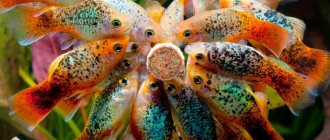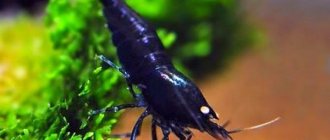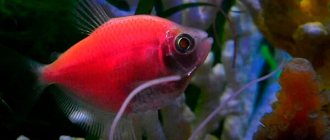The golden gourami is a very beautiful fish, which is descended from the classic form - the spotted gourami. The world first learned about it in 1970, when aquarists spent a long time selecting and crossing until they achieved a stable and beautiful color of the golden gourami.
Habitat in nature
The species was first bred by breeders in 1970 by hybridizing the spotted gourami and was named gold gourami.
Accordingly, it is a purely aquarium fish and is not found in nature. In nature, fish live in low-lying and flooded areas.
Swamps, canals, ponds, streams and lakes - they can be found everywhere. They prefer standing or slow-moving water and abundant vegetation. Omnivores, eat a variety of insects.
Aquarium fish: how to make the right choice
People who decide to have aquarium fish are faced with a rather difficult question - what kind of pet to choose. If you search well, you will find that you will have to choose from almost 2,000 species of a wide variety of freshwater fish. On this page we tried to collect all the necessary information about the aquarium fish - golden gourami. If you have never had an aquarium before, you don’t need to choose based on the principle of a beautiful fish and an ugly fish. It is necessary to take into account a lot of variables: what kind of food it prefers, the temperature and composition of the water, whether it is a predator or not, whether it is dangerous for humans, whether it gets along with other species, and many other interesting things. If we classify conditionally, we can distinguish two large groups of fish:
- Easy-to-care fish, not at all demanding of environmental conditions, can survive even in unfavorable situations. They have high endurance by nature, because they live in places where water constantly changes its characteristics or even disappears for a while. However, for health and beautiful appearance, such fish need to be provided with conditions as similar as possible to their natural habitat.
- Difficult to care for fish, most of them belong to tropical latitudes. For them, you need to create special conditions in the aquarium, again as similar as possible to the area where they live in nature. These species rarely breed in captivity, so they are brought from the wild.
For a novice fish breeder, it is better to choose one of the most unpretentious species. In addition to the prospect of not being able to cope with caring for a “capricious” fish, there is a danger of introducing an exotic disease that can harm the rest of the flora and fauna of the aquarium. If you like the golden gourami aquarium fish, carefully read the characteristics, character, feeding, care and breeding of these fish.
Description
This species, like all other gourami, belongs to the labyrinth group, that is, they can also breathe atmospheric oxygen, except for that dissolved in water. To do this, they rise to the surface and swallow air. This feature allows them to survive in water with low oxygen levels.
Another feature of labyrinths is that the male builds a nest from air bubbles during spawning. Then the female lays eggs in it, and the male jealously guards it, periodically adjusting the nest.
Description: the fish has an elongated and laterally compressed body. Large fins are rounded. The pelvic fins have turned into thin antennae, with which they feel everything around. Gourami breathe atmospheric oxygen, which helps them survive in various bodies of water, even where there is very little air in the water.
They can grow up to 15 cm, but usually somewhat less. Life expectancy is 4-6 years, and they begin to spawn when they reach a size of 7-8 cm.
The body color is golden with dark spots along the back. There are golden and dark spots scattered on the fins; in general, the fish is very beautiful and compares favorably with its natural form.
Appearance
The golden gourami has a tall, elongated body. The maximum size is 15 cm. The mouth is small, slightly elongated upward. The dorsal fin is short and is a distinctive sexual characteristic: in males it is pointed, in females it is rounded. The anal fin is very long and wide, stretches from the middle of the abdomen to the base of the tail, with yellow spots scattered across it.
Golden gourami. Appearance
The pectoral fins are of particular interest. They have changed into thin threads, almost equal to the length of the body, and perform the function of organs of touch: fish use them to feel the area as they move, new objects in the aquarium, and other fish when they meet.
Pectoral fins modified into threads - an organ of touch
The body is golden-orange, with dark stripes of various shapes in the upper part. Two black spots (like blue gouramis) may appear on the body - one at the base of the tail, the other closer to the middle of the body.
The average lifespan in an aquarium is 6 years.
Content complexity
An undemanding fish that can live in various conditions. They are also undemanding when it comes to food. However, upon reaching sexual maturity, it can become slightly aggressive.
Overall, it’s great for beginners, but you just need to choose your neighbors carefully.
Although they differ in color from other species, in all other respects they are the same and they need similar conditions. This is a very hardy fish that is good for beginners.
They live quite a long time and have interesting behavior, they use their pelvic fins to feel the world around them.
Adviсe
- One lemon gourami should require at least 10 liters of water, excluding soil, vegetation and decoration.
- It is better not to keep several males in a cramped room. This provokes aggressive behavior directed at each other and other small fish in the aquarium.
Lemon gouramis go well with almost all fish and decorate the aquarium. And their unpretentiousness and high survival rate in any conditions make them invaluable pets for beginning aquarists.
Previous
Fish6 species of catfish Gyrinocheilus
Next
Macropod fish - fish for a small aquarium
Feeding
They are omnivores and will eat all types of food - live, frozen, artificial.
The basis of feeding may well be branded flakes, and additionally you can feed with bloodworms, coretra, brine shrimp and other types of small feeds.
An interesting feature of gouramis is that they can eat snails and hydras. If snails are more or less safe, then hydra is a tiny pest that can catch small fish and fry with its tentacles containing poison.
So if you have hydras, get a gourami, including a golden one.
Diseases and prevention
Most species of Gourami, even selectively bred, have excellent health and strong immunity. But if infection does occur, then most often the reason is a violation of the conditions of detention.
Be sure to remove those fish that cause concern due to their unusual behavior and appearance, and keep new pets in quarantine for one or two weeks.
The following diseases can be extremely rare among Gouramis:
- Lymphocytosis. They manifest themselves in the appearance of wounds, nodules, swellings, and plaques on the body. Most often, the lesions involve the fins and can be removed by cauterization. Consultation with an experienced ichthyologist is needed, and the tank will have to be completely disinfected and restarted.
- Pseudomonosis. They are characterized by the appearance of dark areas on the scales, which gradually become ulcers.
- Aeromonoses. This is oxygen starvation, most often caused by overpopulation of an artificial reservoir. It is especially dangerous for labyrinth fish and often quickly leads to death. Pets lose their appetite, lie down on the bottom, their scales take on a disheveled appearance, and their abdomen may bleed.
Most often, Methylene blue, Bicillin-5, Oxytetracycline, and Rivanol are used to treat these diseases.
Maintenance and care
They are very unpretentious, but the water still needs to be changed regularly. It’s just that some people think that if they live in dirty water, then they don’t have to clean the aquarium.
However, no labyrinth apparatus will save you from toxins...
An aquarium of 80 liters or more is required for maintenance, although youngsters will live in smaller volumes. It is necessary to keep the water in the aquarium as close as possible to the air temperature in the room, since due to the temperature difference, the gourami’s labyrinth apparatus may be damaged.
Filtration is not necessarily strong, but it is important that there is no strong current, they love calm water.
The aquarium should be decorated and planted in such a way that both dominant and less dominant individuals can find shelter from each other. This means that you need to create several shelters and plant more plants.
The soil can be any, but they look best on dark soils. It is also good to put floating plants on the surface, but make sure that they do not cover the entire water surface so that the fish can breathe.
Water parameters may be different, but the optimum will be: temperature 23-28 ° C, pH: 6.0-8.8, 5 - 35 dGH.
Breeding honey gourami
The sex can be determined by the dorsal fin. The male's dorsal fin is longer and pointed at the end, while the female's is shorter and rounded. Golden gourami reaches sexual maturity at the age of 1 year.
Before spawning, a pair of golden gouramis are fed generously with live food. During spawning, the golden gourami builds a nest. The spawning aquarium should be ~50 liters. The water level for golden gourami is not as critical as for other species, but it is better to keep it low, about 13-15 cm. Water parameters are the same as in a general aquarium, only the temperature rises a couple of degrees, 26 - 27C. Place floating plants, such as duckweed, on the surface of the water; they will serve as a building component for the nest. After the pair reaches the spawning area, the male will begin to build a nest, usually in a corner. As soon as it is completed, mating games begin, the male swims in front of the female, spreading his fins until she allows him to hug her. The male tightly hugs the female with his body, squeezing eggs out of her and at the same time inseminating. The eggs are lighter than water and immediately float to the nest. An adult female can lay more than 800 eggs.
Compatibility
Although this is a color variation, they are somewhat more warlike than other species and the males can fight with each other.
It is better to keep a couple to avoid fights. However, much depends on the conditions and the character of the fish; they can be wonderfully peaceful for some and pugnacious for others. It is better to select neighbors who are fast or the same size as them, for better compatibility.
They are good hunters and love to hunt fry by tracking them at the surface of the water.
Compatible with small and non-predatory fish species, with most characins and viviparous fish.
How to distinguish a female gourami from a male?
Beginning aquarium fish lovers always pay attention to cute gouramis, which attract not only their beauty, but also their calm, peaceful disposition. Having seriously thought about breeding such fish, many people have a question about how to distinguish gourami by gender. But in fact, it turns out that determining the sex of a fish is quite easy. Now we will tell you about everything in more detail.
Color
Next, you should pay attention to the color of the fish. As a rule, the characteristic color appears in gourami immediately before spawning. Pay attention to the color of your fish's belly. In males it is painted bright scarlet or orange. This applies to those fish that initially have a bright color.
If in front of you is a pearl-colored pet, then a barely noticeable red stripe appears on its abdomen during this period. In males of a different color, for example, “honey” ones, either a red stripe appears or the abdomen becomes a darker shade. In spotted males, small spots on the fins become more saturated and bright in color, and the body is slightly darker than usual. The stripes become almost black.
It is worth noting that it is possible to distinguish a female from a male by color not only during the breeding season.
All boy fish have a brighter and more saturated color than girls.
Other differences
During the period of their active growth, females gain weight much faster. As a result, the female’s body becomes denser and fuller. Males, while growing up, remain more “slender”.
If you still doubt whether the bird in front of you is a male or a female, you can find other differences between them. For example, they also differ in character. If you carefully observe the behavior of your aquarium fish, you will soon understand that gouramis also differ in character. Males are much more active and mobile.
Boy gourami can show real masculine character if you carefully observe their behavior. And although they are peaceful and friendly fish, when an opponent approaches, they begin to behave very aggressively and actively defend their territory. That is why experts recommend purchasing a large aquarium to provide them with more comfortable conditions. If several males live in a small aquarium, they will constantly fight for territory.
Before spawning, not only the color changes, but also the behavior of the fish. If you notice that your pets have begun to chase each other in the aquarium, then pay attention to who exactly is trying to catch up. As a rule, it is the males who chase the females, thereby attracting their attention.
It is worth noting that the boys do not show any aggression towards the females at all. During this “race”, males often find themselves in the upper layer of water and actively release bubbles.
If such a “race” does not occur during the spawning period, then, most likely, these are males chasing each other. Usually this behavior indicates that they cannot divide the territory.
How to determine the gender of gourami is described in the following video.











